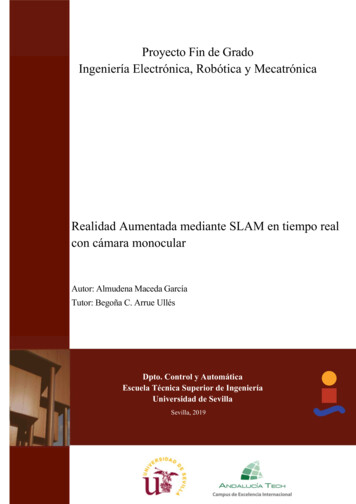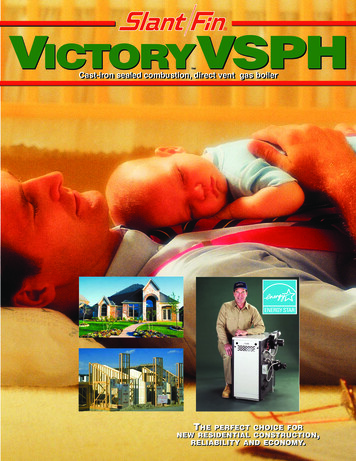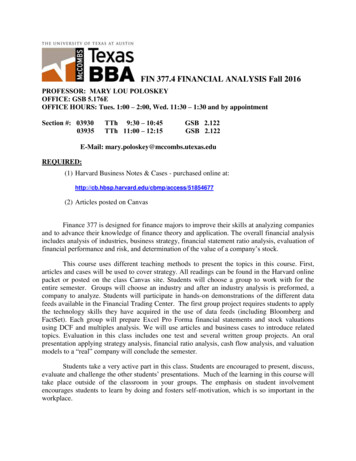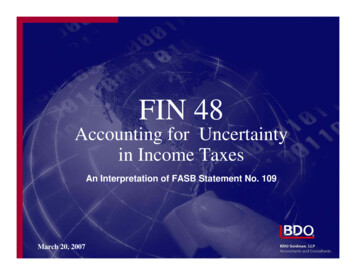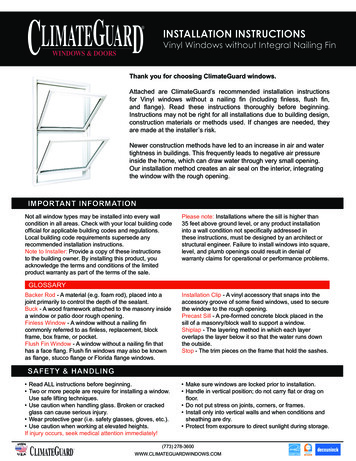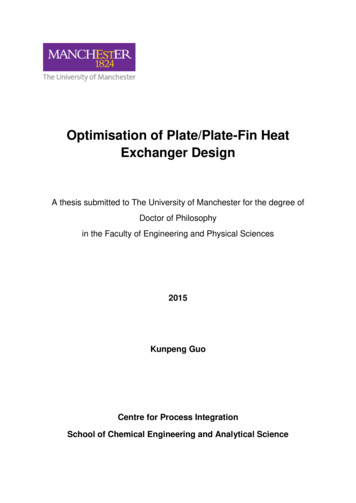
Transcription
Optimisation of Plate/Plate-Fin HeatExchanger DesignA thesis submitted to The University of Manchester for the degree ofDoctor of Philosophyin the Faculty of Engineering and Physical Sciences2015Kunpeng GuoCentre for Process IntegrationSchool of Chemical Engineering and Analytical Science
Table of ContentsList of Tables . 4Optimisation of Plate/Plate-fin Heat Exchanger Design . 5Declaration . 6Copyright Statement . 7Acknowledgment . 9Chapter 1 Introduction . 101.1 Challenges for application of plate/plate-fin heat exchangers . 111.1.1 Plate-fin heat exchangers. 111.1.2 Plate heat exchangers . 121.1.3 Optimisation . 141.2 Objectives of this thesis . 141.3 Overview of this thesis . 15Chapter 2 . 17Publication 1: Optimisation of Fin Selection and Thermal Design of Countercurrent Plate-fin Heat Exchangers. 17Chapter 3 . 21Publication 2: Design Optimisation of Multi-stream Plate Fin Heat Exchangerswith Multiple Fin Types . 21Chapter 4 . 18Publication 3: Optimisation of Two-stream Multi-pass Plate Heat ExchangerDesign . 18Chapter 5 . 19Publication 4:Design Optimisation of Multi-stream Multi-pass Plate HeatExchangers with Phase Change . 19Chapter 6 Conclusions and Future Work . 216.1 Conclusions . 212
6.2 Future work . 22Reference . 24Appendix A: Fin Types with Detailed Geometry . 27Appendix B: GAMS Code Sample . 313
List of TablesTable 1 Energy consumption comparison of last 20 years. 104
Optimisation of Plate/Plate-fin Heat ExchangerDesignKunpeng GuoThe University of Manchester2015Abstract-PhD ThesisWith increasing global energy consumption, stringent environmental protection legislationand safety regulations in industrialised nations, energy saving has been put under highpriority. One of the most efficient ways of energy reduction is through heat transferenhancement for additional heat recovery. Applying compact heat exchanger is one of themain strategies of heat transfer enhancement. However, the application of compact heatexchangers is prohibited by the lack of design methodology. Therefore, the aim of thisresearch is to tackle the problem of developing optimisation methodologies of plate/platefin heat exchanger design.A mathematical model of plate-fin heat exchanger design is proposed to consider fin typeselection with detailed geometry and imposed constraints simultaneously. The concept ofmix-and-match fin type combinations is put forward to include all possible fin typecombinations in a heat exchanger. The mixed integer nonlinear programming (MINLP)model can be converted to a nonlinear programming (NLP) model by employing continuousheat transfer and pressure drop correlations and considering the basic fin geometricparameters as continuous variables. The whole optimisation is based on volumetricminimisation or capital cost minimisation and completed by CONOPT solver in GAMS. Casestudies are carried out to demonstrate the effectiveness and benefits of the new proposedmethodology.For plate heat exchangers, the design methodology is developed on the basis of plate-finheat exchanger methodology, and takes phase change, plate pattern selection, flowarrangement and pressure drop constraints simultaneously. The phase change problem istackled by dividing the whole process into several subsections and considering constantphysical properties in each subsection. The performances of various flow arrangements areevaluated by correction factors of logarithmic mean temperature difference. For two-phaseconditions, the heat transfer and pressure drop performance are predicted by continuoustwo-phase Nusselt number and Fanning friction factor correlations to avoid the MINLPproblem. The optimisation is solved by CONOPT solver as well. The feasibility and accuracyof the new proposed methodology is examined by case studies.5
DeclarationNo portion of the work referred to in the thesis has been submitted in support of anapplication for another degree or qualification of this or any other university or otherinstitute of learning.Kunpeng Guo6
Copyright Statementi.The author of this thesis (including any appendices and/or schedules to thisthesis) owns certain copyright or related rights in it (the “Copyright”) and s/hehas given The University of Manchester certain rights to use such Copyright,including for administrative purposes.ii.Copies of this thesis, either in full or in extracts and whether in hard or electroniccopy, may be made only in accordance with the Copyright, Designs and PatentsAct 1988 (as mended) and regulations issued under it or, where appropriate, inaccordance with licensing agreements which the University has from time totime. This page must from part of any such copies made.iii.The ownership of certain Copyright, patents, designs, trademarks and otherintellectual property (the “Intellectual Property”) and any reproductions ofcopyright works in the thesis, for example graphs and tables (“Reproductions”),which may be described in this thesis, may not be owned by the author and maybe owned by third parties. Such Intellectual Property and Reproductions cannotand must not be made available for use without the prior written permission ofthe owner(s) of the relevant Intellectual Property and/or Reproductions.iv.Further information on the conditions under which disclosure, publication andcommercialisation of this thesis, the Copyright and any Intellectual Propertyand/or Reproductions described in it may take place is available in the ac.uk/Doculnfo.apsx?DocuInfo.aspx?DocID 487), in anyrelevant Thesis restriction declarations deposited in the University Library, manchester.ac.uk/library/aboutus/regulations) and in The University’spolicy on Presentation of Thesis.7
Dedicated to My Father8
AcknowledgmentI would like to express my immeasurable appreciation and deepest gratitude to mysupervisor, Dr. Nan Zhang for his valuable guidance, comments, suggestions andencouragement, without which this work would not have been possible. For his unwaveringsupport, I am truly grateful. I am also grateful to my co-supervisor, Prof. Robin Smith for hissuggestions and support towards the successful completion of three-year ProcessIntegration Research Consortium oral presentations.Without the financial support of the University of Manchester which offered me ascholarship for PhD studies, this would not have been possible.To the beloved parents and my wife for untiring love, thoughtfulness and financial support;To all members of the Centre for Process Integration for providing a friendly researchenvironment.Special thanks to Dr. Luyi, Dr Maria, Victor, Fei, Luwen, Chengjun, Shixun, Yunrui and Shiqifor their encouragement and moral support which made my stay and studies in Manchestermore enjoyable.9
Chapter 1 IntroductionGlobal demand for energy has risen steadily in the last 20 years in step with industrialdevelopment and population growth, which is shown in Table 1 (BP, 2004, 2015). Coupledwith stringent environmental protection legislation and safety regulations in industrialisednations, energy saving has been paid more and more attention. One of the main strategiesfor energy saving is to recover the heat already generated in the process as efficiently andeconomically as possible. Heat recovery not only saves on primary energy, but alsocontributes to environmental protection due to reduced emissions. One way to improveheat recovery performance is through heat transfer enhancement. Nowadays, a significantnumber of thermal engineering researchers are seeking new heat transfer enhancementmethods. Thermal reuse requires efficient and economically designed heat exchangers. Themost efficient and widely accepted heat exchanger is compact heat exchangers (Kays andLondon, 1984).Table 1 Energy consumption comparison of last 20 yearsEnergy ConsumptionMillion tonnes oil 13922.94211.1Nature ydroelectricity539.5602.9634.4737.4879.0Renewable 7.512928.4Compact heat exchangers are a class of heat exchangers that incorporate a large amount ofheat transfer surface area per unit volume. The typical and commonly used compact heat10
exchangers include plate heat exchangers and plate-fin heat exchangers (Kays and London,1984). These compact heat exchangers are characterised by: Small minimum approach temperature: Compared with 10-20 C in the shell and tubeheat exchanger, the minimum approach temperature in the compact heatexchangers can be as low as 2-5 C, which contributes to more heat recovery dutiesand less utility requirements. Large heat transfer surface area: the heat transfer surface area of compact heatexchangers can reach 1000m2/m3, which is twice as large as that of shell and tubeheat exchangers. High heat transfer coefficient: Due to small hydraulic diameter or inserted fins, thefluid turbulence is enlarged and the local convective heat transfer coefficient isenhanced correspondingly. Possibility of handling several streams in one unit: this unique structure gives anopportunity of reducing the number of heat exchangers and reduces the capital costof heat exchangers.Based on the above distinguished advantages, compact heat exchangers are widely used invarious energy-intensive process industries, such as refrigeration, petrochemical plants,refineries and natural-gas processing (Hesselgreave, 2001).1.1 Challenges for application of plate/plate-fin heat exchangersThe application of plate and plate-fin heat exchangers falls far behind shell and tube heatexchangers. The major challenges are the lack of generalised heat transfer and pressuredrop correlations and design optimisation methodologies.1.1.1 Plate-fin heat exchangersPlate-fin heat exchangers consist of a series of fin surfaces sandwiched between partingsheets and stacked together. The introduced fin, work as a secondary surface, can increaseefficient heat transfer area and transfer heat to fluid through parting sheets, enlarge fluidturbulence and enhance the local convective heat transfer coefficient to increase theefficiency of heat transfer (Shah, 2003). According to Kays and London (1984), there are11
approximately sixty standardised fin parts (plain fin, louvered fin, offset strip fin and wavyfin) with specific heat transfer and pressure drop performance. A major challenge indesigning optimal multi-stream plate fin heat exchangers is the lack of fin selection methodand the method how to address the discrete design problem caused by standardised fintypes.In the past decades, many publications proposed various design methodologies of multistream plate-fin heat exchangers. Shah (1982) and Cowell (1990) analysed individual fins invarious ways: volume vs. power consumption, frontal area vs. power consumption, areagoodness. But these qualitative analysis can only give a general guide on selection of fintypes. Lee and Zhu (1999) proposed two new concepts: identical-fin concept and Z-Y graphto select optimum fin types to select fin types. This time-consuming screening method usesthe same fin type for all streams in the early design stage and ignores the benefits of mixand match fin types, which may not reach the smaller plate fin heat exchanger size. PiconNunez et al. (2002) rearranged heat balance equations, proposed a new term “VolumePerformance Index” and plotted a graph of VPI vs Reynolds number to select appropriate fintypes. This trial and error design methodology is based on assumed Reynolds number andneglects the effect of imposed design constraints on fin selection, which will deviate fromthe real design. Recently, Peng, et al. (2008) and Yousefi, et al. (2012) took basic fingeometries as
heat exchanger methodology, and takes phase change, plate pattern selection, flow arrangement and pressure drop constraints simultaneously. The phase change problem is tackled by dividing the whole process into several subsections and considering constant physical properties in each subsection. The performances of various flow arrangements are evaluated by correction factors of logarithmic .




